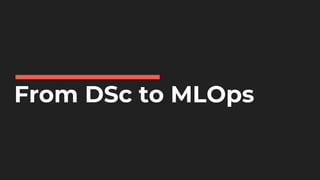From Data Science to MLOps
- 1. From DSc to MLOps
- 2. ¿Who am I? Hi my name is Carl! ● MSc Computer Science (ITESM) ● Head of Data Science RappiPay ● DataPub @CDMX carlwhandlin.com linkedin.com/in/carlhandlin/
- 3. About 7/10 companies report little or no impact with the use of AI.* 40% of organizations with significant investments in AI report no benefits.* Reality is: ● AI is a source of opportunities and advantages ● Implementing AI is a risk ● Implementing AI correctly is difficult * According to the MITSloan and BCG 2019 survey
- 4. ● Gap between development and deployment into production Only 22% of companies using ML have successfully deployed an ML model into production* 87% of data science projects never make it into production.* The main challenges people face when developing ML capabilities are scale, version control, model reproducibility, and aligning stakeholders. Deployment Gap *According to the 2019 Algorithmia’s “State of Enterprise ML” survey
- 5. Ideal Collection and Transformation Monitoring and Feedback Process and Training Evaluation and Validation Enablement and Deployment* ML Cycle
- 6. IRL (In Real Life…)
- 7. Why? ML Code Data Collection Testing and Debugging Model Analysis Resource Management Process Management Data Verification Automation Configuration Feature Engineering Infrastructure Monitoring
- 8. BUT WAIT… I’m Data Scientist why should worry about this? HINT: you want people to use it and your model to work!
- 9. MLOps Machine Learning DevOps Data Engineering MLOps “The extension of the DevOps methodology to include Machine Learning, Data Science and Data Engineering assets as first-class citizens within the DevOps ecology”
- 10. As ML & AI propagate in software products, we need to establish best practices and tools to test, deploy, manage, and monitor ML models in real-world production. Key Pillars DESIGN a.k.a Think DEVELOPMENT a.k.a Build OPERATION a.k.a Run
- 11. Key Concepts & Components ● Iterative-Incremental Dev ● Automation ● CT/CI/CD ● Versioning ● Testing ● Reproducibility ● Monitoring ● Source Control ● Test & Build Services ● Deployment Services ● Model Registry ● Feature Store ● ML Metadata Store ● ML Pipeline Orchestrator
- 12. Maturity Level 1 Data Data Extraction & Analysis Data Preparation Model Training Model Evaluation & Validation Trained Model Registry Serving Prediction Service ML Ops
- 13. Maturity Level 2 / Automation Data Data Extraction & Analysis Data Preparation Model Training Model Evaluation & Validation Source Code Repository Prediction Service Feature Store Automated Pipeline Trained Model Registry Monitoring Service
- 14. The MLOps Tech Stack A Tech Stack should able (at least in some way) to do this: ● Data engineering ● Version control of data ● ML models and code ● Continuous integration and continuous delivery pipelines ● Automating deployments and experiments ● Model performance assessment ● Model monitoring in production. Think in terms of concepts instead of components
- 15. The MLOps Tech Stack MLOps Setup Components Tools Data Analysis Python, Pandas Source Control Git Test & Build Services PyTest & Make Deployment Services Git, DVC Model & Dataset Registry DVC[aws s3] Feature Store Feast ML Metadata Store DVC ML Pipeline Orchestrator Airflow
- 16. Traceability / Reproducibility ● What went wrong? ● DVC Data Version Control $ dvc init $ git commit -m "Initialize DVC" $ dvc remote add -d myremote/tmp/storage $ dvc add my-dataset.csv $ dvc push
- 17. Automating the ML Pipeline ● Apache Airflow ● Kubeflow ● Luigi ● Argo ● MLFlow ● … Can I use CI/CD tools?
- 18. ● Airflow is a platform to create, monitor and schedule flows. ● Each flow in airflow is presented as a DAG (Directed Acyclic Graph) of Tasks They run independently. ● Flows are created from Python code. Apache Airflow
- 19. Apache Airflow
- 20. Flask ● Python API Framework ● Works with all Python ML frameworks Serving https://github.com/cwallaceh/sklearnflask_docker
- 21. Deploying Level 1 Simplest architecture Model Server with API ML Model Client Client Serverless ML Model
- 22. Docker container Deploying Level 2 Simplest architecture containerized Model Server with API ML Model Client
- 23. Containers ● Containers have everything the app needs to run including libraries, system tools, code, and runtime ● Containers emulate the operating system ● Lightweight and fast! ● This allow for microservices ● Docker!
- 24. Containers ● Reproducibility ● Isolation ● Security ● Environment Management ● Continuous Integration ● Scalability ○ ...with Kubernetes or Swarm
- 25. Kubernetes Deploying Level 3 Simplest architecture containerized and scalable! Client Docker container Docker container Docker container Docker container
- 26. Other alternatives ● Tensorflow Serving ● MLflow ● Cloud Options: ○ AWS ○ GCP ○ Azure ● Tensorflow.js directly into the browser!
- 27. ● Mostly problems can be: ○ Data Monitoring (Inputs): ■ Data Drift ■ Input Distribution ■ Data Checks ■ ... ○ Prediction Monitoring (Outputs) ■ Prediction Distribution ■ Model Performance ■ ... ○ Operations issues ■ System Performance ■ Uptime ■ Response time Monitoring!
- 28. **Monitor 1:** Dependency changes result in notification **Monitor 2:** Data invariants hold in training and serving inputs **Monitor 3:** Training and serving features compute the same values **Monitor 4:** Models are not too stale **Monitor 5:** The model is numerically stable **Monitor 6:** The model has not experienced a dramatic or slow-leak regressions in training speed, serving latency, throughput, or RAM usage **Monitor 7:** The model has not experienced a regression in prediction quality on served data Key Monitoring Principles *The ML test score: A rubric for ML production readiness and technical debt reduction.
- 29. Thank you!
